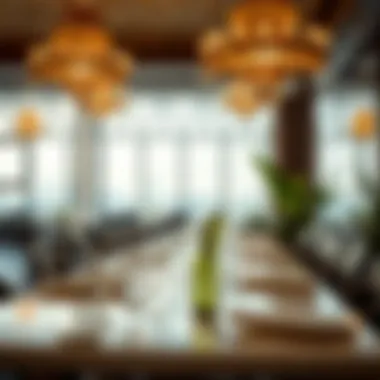Discovering Dubai's Finest Arabic Dining Experience


Intro
In the heart of Dubai, where the city’s skyline kisses the clouds and luxury whispers from every corner, lies a culinary treasure trove of Arabic cuisine. This article aims to uncover what makes an Arabic restaurant truly exceptional in this bustling metropolis. With a melting pot of cultures, visitors and locals alike seek dining experiences that ignite the senses. Factors such as culinary authenticity, ambiance, service quality, and cultural significance are pivotal in discerning the best Arabic dining spots.
Dubai's rich culinary tapestry invites both esteemed chefs and budding restaurateurs to present their interpretations of Arabic traditions. From traditional dishes served in modern bistros to the fusion of flavors in upscale eateries, the choice can indeed be daunting for anyone navigating the city’s diverse food scene. This examination will spotlight restaurants that not only serve delicious meals but also encapsulate the essence of Arabic hospitality.
As we embark on this gastronomic journey, we’ll explore the current market trends in Dubai’s Arabic dining sector, revealing where the best opportunities lie. We will delve into investment insights for those looking to dive deeper into this thriving culinary landscape. Each establishment presents a unique flavor and experience, making them noteworthy contenders in the region's competitive dining scene. Invite your taste buds and let’s uncover the best Arabic restaurants Dubai has to offer.
Understanding Arabic Cuisine
Understanding Arabic cuisine is at the heart of appreciating the dining experience that Dubai offers. Arabic cuisine is vastly rich, brimming with flavors, spices, and traditions that reflect a wide array of cultural influences. At its core, it represents a fusion of diverse heritages spanning centuries, from the indigenous Arabian elements to influences from North Africa, the Levant, and even beyond the Mediterranean.
In this article, recognizing the foundations of Arabic cuisine and its rich historical context is essential. It sheds light on how food not only nourishes the body but also serves as a bridge connecting various cultures over shared meals and traditional dishes. When it comes to the best Arabic restaurant in Dubai, understanding these nuances allows diners to appreciate each dish not just for its taste, but also for the stories and artistry behind it.
"Food is symbolic of love when words are inadequate." This quote encapsulates the notion that food in Arabic culture transcends mere sustenance—it’s a celebration of togetherness, hospitality, and identity.
Historical Context
Arabic cuisine stems from a complex interplay of historical events, migration, trade routes, and cultural exchanges. To truly grasp the essence of this culinary tradition, one must consider how factors like the ancient Silk Road and the spice trade influenced cooking styles and ingredient accessibility.
Take for instance, the introduction of spices such as cumin, coriander, and saffron. These spices, once transported from Asia, have found their way into Arabic kitchens, transforming flavors and enhancing the culinary repertoire. Furthermore, historical narratives surrounding food reflect the cultural amalgamation that Arab nations experienced due to trade conquests and colonial influences. Each dish resonates with stories of bygone eras, echoing the identity of its people.
Additionally, many traditional dishes we enjoy today have roots that can be traced back to ancient civilizations. Some favorites, like kibbeh and falafel, showcase how adaptations have occurred over time, marrying convenience with tradition. In recognizing these historical factors, diners are better positioned to appreciate the depth of the flavors they encounter.
Regional Variations
Just as one wouldn’t expect the exact same weather in a vast country, expect similarly distinct variations in Arabic cuisine across different regions. It’s important to note that while many elements appear universal, each locale unfolds its own character through local ingredients, cooking methods, and cultural practices.
In the Levant, for example, you might savor tabbouleh—a herbaceous salad made predominantly with parsley and bulgur. A trip to the Gulf region, on the other hand, might present you with machboos, a fragrant rice dish flavored with a blend of aromatic spices, often accompanied by succulent meats.
Moreover, North African cuisines, notably Moroccan, bring a zest and color synonymous with dishes like tagine and couscous, which are not merely meals but artisan representations of culinary heritage.
Key Points to Remember:
- Culinary History: Arabic foods are deeply intertwined with the historical context of trade and cultural exchanges.
- Cultural Significance: Each dish tells a story that connects back to its origins and traditions.
- Regional Diversity: From the spices of North Africa to the herbs of the Levant, every region brings its unique flare, showcasing the richness of Arabic cuisine.
Recognizing these variations enriches the experience of dining at Arabic restaurants in Dubai as one can appreciate the types of dishes being served and the history they carry.
The Culinary Scene in Dubai
Dubai's culinary landscape is as vibrant as the city itself, acting as a melting pot of diverse cultures and traditions. The importance of this scene cannot be understated; it’s not just about food but also how it reflects the city's ever-evolving identity. With various influences from around the region and beyond, dining in Dubai serves as both a social experience and a cultural exploration. Here, traditional Arabic restaurants stand out, offering exceptionally authentic dishes while simultaneously adapting to global trends.
Emerging Trends
In recent years, Dubai has seen a surge in innovative dining experiences that blend tradition with modernity. Notably, the trend of 'fine casual dining' has emerged, where high-quality ingredients meet a more relaxed atmosphere. Restaurants like Al Nafoorah and Coya are at the forefront of this movement, offering refined Arabic dishes alongside contemporary flair. Such places often prioritize sustainable sourcing, showcasing local produce, which not only appeals to the eco-conscious diner but also connects the meal back to the rich landscape of the region.
Moreover, vegan and vegetarian options in Arabic cuisine are gaining traction. Traditional ingredients are being reimagined to cater to a growing demographic concerned with health and wellness. A dish like the Mujadara, made from lentils and rice, has become a favorite, proving that Arabic food can adapt without losing its roots.
Cultural Fusion
The cultural fusion evident in Dubai's culinary scene exemplifies the city's dynamic nature. Arabic restaurants are increasingly incorporating flavors from other cuisines, leading to unique fusions that captivate the palate. This exchange brings a new layer of complexity to traditional dishes, whether it be through the infusion of Indian spices in Mandi or the incorporation of Mediterranean techniques into Shawarma preparation.
This blending is not merely a gimmick; it highlights the interaction between various communities that have established roots in Dubai. Take, for example, the exponential rise of Korean fried chicken infused with Arabic spices. It’s a dish that has quickly gained popularity among locals, showcasing how culinary traditions can journey across cultures and still resonate with the fundamental aspects of each.
In these spaces, food becomes a conversation starter, a way to break down barriers and build connections. Diners in Dubai not only relish flavors but also indulge in a narrative of shared experiences spanning continents.
"Dining isn't just about feeding the body; it’s a celebration of our many cultures brought together."


In summary, the culinary scene in Dubai stands as a testament to the city's identity as a crossroads of the world. By embracing both emerging trends and cultural fusions, Arabic restaurants play an essential role in this narrative, marking Dubai not only as a place to visit but a destination to truly experience diverse flavors.
Criteria for the Best Arabic Restaurant
Understanding what makes an Arabic restaurant stand out is crucial for anyone looking to enjoy a memorable dining experience in Dubai. Several factors come into play when determining the best of the best, from the ingredients used to how the ambiance sets the mood. Here are the critical elements one should consider:
Quality of Ingredients
The foundation of any exceptional dish lies in its ingredients. In Arabic cuisine, this means fresh produce, high-quality proteins, and authentic spices. Sourcing local meats and vegetables not only supports community farmers but also enhances the overall flavor profile of the dishes. For instance, an Arabic restaurant that prides itself on using organic, locally-sourced lamb for its mutton kebabs speaks volumes about its commitment to quality. Additionally, the inclusion of spices such as saffron, sumac, and za'atar, when derived from reputable suppliers, can elevate the taste and authenticity of the food. So, if you're eyeing a restaurant that appears to have a consistent crowd, it might very well be due to its carefully chosen ingredients.
Authenticity of Dishes
When dining out, especially in a diverse city like Dubai, authenticity can often make the difference between an average meal and a culinary revelation. An Arabic restaurant that offers dishes true to the regional heritage—like a Jordanian mansaf or Lebanese tabbouleh—provides an experience that transports diners straight to the heart of the culture. This authenticity often reflects in the preparation methods as well; for example, a restaurant that employs traditional cooking techniques, such as slow-roasting meats in a tannour, showcases an adherence to historical practices that honor the origins of the cuisine. Diners can taste the history in every bite, making authenticity an essential criterion when rating restaurants.
Ambiance and Decor
The setting of a restaurant plays a pivotal role in shaping the overall experience. From intricate tile work inspired by Arabic mosaics to warm lighting that mimics the sun setting over the desert, the decor often tells a visual story that complements the dining experience. Moreover, seating arrangements that encourage intimacy and conversation can significantly enhance the meal. A restaurant that manages to create such an environment not only becomes a place to eat but a destination where cultural convergence takes place. Roaming lanterns, lush fabrics, and the subtle scent of shisha wafting through the air create an immersive experience where patrons can savor not just the food, but the atmosphere as well.
Service Standards
Last but certainly not least, attentive and knowledgeable service is crucial. A restaurant that offers personalized recommendations, understands customer preferences, and swiftly addresses any concerns portrays professionalism and a commitment to customer satisfaction. Imagine being greeted like an old friend, with staff members well-versed in the menu and excited to share stories about each dish. High standards of cleanliness and an effort to make every diner feel special can be the cherry on top of a wonderful meal. In a city that attracts tourists from all over the world, service can either make or break a visit, which is why it deserves careful consideration in any best restaurant assessment.
"The mark of an excellent restaurant is one that not only fills your stomach but also nurtures your spirit."
Top Arabic Restaurants in Dubai
The culinary landscape of Dubai is a captivating tapestry of flavors and traditions, and it’s essential to explore the top Arabic restaurants that define this vibrant scene. These establishments not only serve food; they offer a culinary narrative that weaves through history, region, and innovation. Understanding the significance of these culinary gems is paramount, as they reflect the cultural identity of the city and the broader Arabic heritage.
Importance of Top Arabic Restaurants in Dubai
Identifying the top Arabic restaurants in Dubai carries significant weight in this exploration of cuisine. These eateries serve as windows into the heart of Arabic culture. They showcase the richness of regional dishes, each prepared with a touch of local flair and authenticity. Diners are not just consuming a meal; they are engaging with the traditions, flavors, and stories that have been passed down through generations.
Moreover, the choice of a top restaurant is often influenced by a myriad of factors such as:
- Culinary Creativity: How chefs incorporate traditional methods with modern innovation, making visits enticing and memorable.
- Authenticity: The extent to which dishes resonate with traditional recipes, which often resonate deeply with both locals and visitors.
- Atmosphere: The decor and overall vibe of the restaurant play a crucial role in enhancing the dining experience.
- Service Excellence: Attentive and knowledgeable staff can transform a meal into a cherished memory.
In this section, we delve into three standout establishments that exemplify these qualities, shedding light on their unique offerings and specialties.
Restaurant A: Overview and Specialties
Restaurant A stands out for its commitment to authenticity, serving traditional dishes from diverse regions within the Arabic world. The vibrant interiors, adorned with intricate mosaics and rich textiles, create an inviting atmosphere for diners.
One of the signature dishes here is Mansaf, perfectly prepared and accompanied by goat meat, rice, and tangy yogurt sauce, reflecting the deep culinary roots of the region. Their use of locally sourced spices elevates the dish, providing a memorable culinary experience that speaks to both tradition and flavor.
Restaurant B: Overview and Specialties
Next, we explore Restaurant B, a hub for culinary innovation. This establishment isn’t afraid to experiment with flavors, offering contemporary twists on classic Arabic cuisine. The ambiance strikes a balance between elegance and comfort, making it an ideal spot for both casual meals and special occasions.
Not to miss is their Lamb Tagine, a slow-cooked dish that sees a modern interpretation through the use of seasonal vegetables and aromatic herbs. It has received rave reviews for its tender meat and rich sauce, showcasing how this restaurant has mastered the art of blending traditionalism with modern flair.
Restaurant C: Overview and Specialties
Finally, Restaurant C boasts a reputation for its stunning views and open-air seating, providing diners with a scenic backdrop to their meals. This location emphasizes dishes that are reflective of the broader regional influences, offering a diverse menu that captures the essence of Arabic dining.
The standout offering here is their Mezze Platter, an array of small dishes that invite sharing and conversation. The fresh flavors of Hummus, Tabbouleh, and Falafel create a colorful and flavorful experience, encapsulating the community spirit of Arabic dining.
"Dubai’s Arabic restaurants are not merely places to eat; they are cultural hubs reflecting the diversity and richness of Arab hospitality."


Dining Experience: What to Expect
When stepping into the world of Arabic dining, a rich tapestry of flavors, scents, and traditions awaits. This section aims to unpack the dining experience you'd encounter at an exceptional Arabic restaurant in Dubai, shining a light on elements that transform a meal into a feast for the senses.
Menu Insights
The essence of any Arabic restaurant lies within its menu, a curated collection that harkens back to the culinary roots of the region, while also incorporating contemporary twists. You can find a blend of beloved classics like hummus, tabbouleh, and kabsa, alongside innovative dishes that reflect the evolving nature of Dubai's food scene. A notable aspect is the emphasis on fresh, seasonal ingredients that showcase a commitment to quality.
- Traditional Dishes: Expect the staple mezze platters, perfected over generations. The selection often leads with an array of dips — moutabel or mutabbal (a smoky eggplant spread) can surprise some.
- Signature Offerings: Many restaurants boast their own specialty dishes, like saffron-infused shorbat adas (lentil soup) or intriguing mashawi (grilled meats) presented in a distinct way.
- Desserts to Remember: No meal is complete without a sweet finish, and the exquisite baklava or kunafa with its syrupy goodness can leave a lasting impression.
Preparation and Presentation
Preparation in Arabic cuisine is as much about tradition as it is about technique. The cooking methods often involve slow-roasting, marinating, and grilling, allowing each dish to develop intricate flavors that resonate with authenticity.
Presentation is where the visual treat begins. Expect to see:
- Artful Plating: Restaurants often take pride in how they present their food, with vibrant colors and diverse textures that enhance the visual feast. Think of fatta, a dish layered elegantly with bread, rice, and meat topped with yogurt.
- Serving Styles: Meals may be served family-style, inviting diners to share dishes. This communal approach enhances the dining experience, fostering not only a connection to the food but also to those around the table.
- Ambiance Influence: The surrounding decor, from intricate tiles to plush cushions, plays a role in how the meal is enjoyed, marrying the food with the cultural riches of the environment.
"Arabic dining is not only about the food; it’s about the whole experience, enveloping each diner in the warmth of tradition and hospitality."
As you navigate through the diverse offerings of Dubai’s Arabic restaurants, understanding the dining experience—what to expect realistically enriches your culinary journey and enhances appreciation of the intricate nuances involved.
Customer Reviews and Feedback
In the competitive landscape of Dubai's culinary scene, customer reviews and feedback play a pivotal role in guiding diners towards the best Arabic restaurants. These reviews offer a window into the experiences of fellow diners, providing insights that the restaurant's marketing materials often miss. A potential patron often looks for authentic opinions before investing both time and money in a dining experience. This section outlines the significance of these reviews, emphasizing their impact on cuisine appreciation and restaurant improvement.
A strong feedback loop not only aids patrons in making informed choices but also shapes the very standards of local dining establishments. Consequently, both customers and restaurant owners benefit from candid exchanges of opinions. In an age where social media and review platforms proliferate, the weight of genuine feedback can wield considerable influence on a restaurant's reputation and, ultimately, its success.
Common Praise
A significant portion of customer reviews highlight aspects that resonate well with diners. Some common areas of praise include:
- Flavor Profiles: Many diners are quick to commend the robust flavors that Arabic cuisine is known for, such as the spices in a well-prepared shawarma or the richness of a traditional tagine.
- Hospitality: Arabic culture is synonymous with hospitality. Numerous reviews often reflect positive experiences regarding the warmth and attentiveness of the staff, contributing significantly to the overall dining experience.
- Ambiance: The atmosphere of a restaurant can enhance the meal, and patrons frequently mention well-designed interiors or outdoor seating options that integrate Dubai's vibrant culture.
"The kebabs at Restaurant A transport you straight to the heart of the Middle East; each bite is a flavor explosion!"
Diners often express joy over the authenticity of dishes. It's not uncommon to find reviews noting how a particular restaurant's food could easily remind one of home-cooked meals from a relative or neighbor. This touch of nostalgia is invaluable and fosters a deeper connection to the restaurant.
Constructive Criticism
While praise is plentiful, constructive criticism is equally important in providing a balanced view. These critiques present opportunities for growth, helping Arabic restaurants refine their offerings and better serve their clientele. Here are some areas where customers have raised concerns:
- Inconsistency: Diners occasionally lament fluctuations in food quality, expressing disappointment when a favorite dish does not meet their expectations during repeat visits.
- Service Delays: Some reviews mention longer-than-expected wait times, particularly in high-demand periods. This delay can detract from what should be an enjoyable experience.
- Pricing Concerns: A few diners criticize perceived price-to-value ratios, suggesting that certain dishes may not warrant the cost based on portion size or flavor.
Feedback such as this, though potentially harsh, is often intended to encourage improvement rather than diminish a restaurant's reputation. Restaurant owners who actively engage with feedback—both positive and critical—can make informed adjustments, ensuring a better experience for future diners. A strong commitment to continuous improvement can differentiate successful establishments from the rest, solidifying their place in Dubai's culinary culture.
The Role of Arabic Restaurants in Dubai's Identity
Arabic restaurants play an integral role in shaping the culinary landscape of Dubai, representing not just a source of nourishment but also a reservoir of cultural heritage. Understanding this role requires a dive into the heart of what makes these establishments more than mere eateries.
Cultural Significance
At the crossroads of tradition and modernity, Arabic restaurants in Dubai serve as cultural ambassadors. They are a reflection of the rich history that Dubai holds, with the culinary arts sitting at the forefront. When one steps into an Arabic restaurant, they are essentially stepping into a narrative where every dish tells a story steeped in centuries of tradition.
The culinary practices and recipes are often passed down through generations, often retaining both their original essence and adapting to contemporary tastes. Ingredients like saffron, cumin, and sumac are not just flavor enhancers; they symbolize the deep-rooted connections to the region’s heritage.
Moreover, these restaurants often celebrate important cultural events and festivals through special menus or themed nights, allowing patrons to immerse themselves in Arabic culture. Think Ramadan, when iftar spreads are filled with traditional dishes, communal dining ethos, and various forms of hospitality that welcome the spirit of togetherness.


In essence, enjoying a meal in an Arabic restaurant is about experiencing the very soul of Arabic culture, where food becomes a medium for storytelling and community building.
Community Engagement
In the bustling city of Dubai, characterized by rapid growth and modernization, Arabic restaurants serve as vital hubs for community engagement. They provide more than just culinary delights; they foster connections among diverse groups of people. The Arabic dining experience often encourages sharing — an act that has cultural significance — making these venues natural environments for camaraderie.
These restaurants typically host local events, cultural nights, and workshops that invite the community to partake in traditional cooking lessons or folklore storytelling sessions. This not only helps preserve the cultural identity but also allows newcomers and expatriates a chance to connect with the local customs and traditions.
Furthermore, many Arabic restaurants are involved in charitable efforts, especially during Ramadan. They actively participate in feeding programs and social initiatives, sparking a sense of goodwill and unity among residents.
"Arabic restaurants in Dubai are more than just places to eat; they are crossroads where culture, community, and compassion intersect."
By supporting local artists, musicians, and artisans, these restaurants contribute to the local economy and promote cultural experiences, effectively weaving the fabric of Dubai’s societal identity.
Future of Arabic Dining in Dubai
As Dubai continues to evolve as a global destination, the future of Arabic dining is poised to reflect this dynamic growth. This topic is significant because it encompasses several layers such as innovation, cultural identity, and environmental responsibility. With Arabs being custodians of an ancient culinary heritage, the future of their dining experiences must balance preserving traditional flavors while adapting to contemporary trends.
Innovations in the Culinary World
In the realm of culinary arts, the innovation that is bubbling beneath the surface is impressive. Chefs and restaurateurs are looking into modern techniques that keep the essence of Arabic cuisine intact while introducing new flavors and presentations.
Some innovative practices include:
- Molecular Gastronomy: This technique provides an entirely new angle to Arabian dishes, with deconstructed dishes that thrill the senses.
- Fusion Cuisine: Restaurants in Dubai are boldly blending Arabic flavors with influences from Southeast Asia or Latin America. This openness to experimentation creates dishes like za’atar-infused tacos or shawarma burgers, which cater to adventurous palates.
- Digital Menu Experience: Many establishments are now employing interactive digital menus that not only showcase their offerings but also tell the story behind each dish’s ingredients and origins. This engages diners on a deeper level and enhances their dining experience.
These innovations not only attract foodies but also help in building a more diverse culinary landscape in Dubai. As these establishments keep popping up, they're not only retaining the core essence of Arabic flavors but also keeping the dining scene lively and ever-evolving.
Sustainability Efforts
As global conversation shifts towards environmental considerations, restaurants in Dubai are leading the charge towards sustainability. From sourcing practices to waste management, the Arabic dining landscape is integrating green initiatives, demonstrating their commitment to the planet.
Considerable efforts include:
- Local Sourcing: Many restaurants are prioritizing locally sourced ingredients to not only ensure freshness but also to minimize the carbon footprint associated with transportation.
- Plant-Based Options: In response to rising health consciousness and environmental awareness, several Arabic restaurants are offering creative vegetarian or vegan dishes that celebrate regional produce.
- Waste Reduction Technologies: Implementing systems that allow for waste tracking and minimizing food waste has become a priority. Some establishments collaborate with charities to donate excess food, fostering community engagement and responsibility.
"In the future, the Arabian dining experience will not only be about taste but also sustainability and ethical practices."
With these focus areas, the future of dining in Dubai is indeed thrilling. Innovations coupled with sustainability efforts reflect a comprehensive approach that ensures cultural heritage thrives while also addressing modern demands and challenges. This trajectory indicates that Arabic dining will not just adapt but lead the way in shaping future culinary experiences, ensuring that diners enjoy both authenticity and progression.
Culmination: Choosing the Ideal Arabic Dining Experience
When venturing into the rich tapestry of Arabic dining in Dubai, one faces not just a variety of exquisite dishes but also a complex landscape of cultural significance and unique experiences. This conclusion weighs the vital aspects that discerning diners should consider when selecting their ideal Arabic restaurant in this bustling metropolis.
In this article, we’ve dissected several key elements: authenticity, quality of ingredients, ambiance, and service standards. Each plays a pivotal role in shaping the overall dining experience.
Importance of Authenticity
Finding a restaurant that stays true to its roots can significantly enhance one’s culinary journey. Whether it’s kebabs, mezze, or a classic biryani, authenticity ensures that patrons are sampling dishes that resonate with their cultural origins. It’s not just about the taste; it’s about telling a story through food. Aim for places where recipes have been passed down through generations.
Quality of Ingredients
The quality of ingredients can make or break a meal. Look for establishments that source local and organic produce, paired with traditional spices that elevate the dining experience. Freshness plays a crucial role in Arabic cuisine; dishes should burst with flavor, each bite transporting you deeper into the heart of the region.
Ambiance and Decor
Next, consider the ambiance. An ideal Arabic restaurant should reflect the hospitality synonymous with Arab culture. From warm lighting to intricate decorations, the setting can provide a backdrop that enhances the meal. Look for spaces that create a comfortable atmosphere, inviting conversation and connection.
Service Standards
Finally, one cannot overlook service. Polite, attentive staff can transform a simple dinner into a memorable event. The best restaurants employ knowledgeable servers who can guide diners through the menu, offering recommendations based on personal tastes. Great service should feel effortless.
"The essence of dining is not just about food, but the bonds it fosters through shared experiences."
In essence, choosing an Arabic dining experience in Dubai is not merely a transaction; it is an opportunity to engage with culture, tradition, and community. With the insights provided, diners can navigate this vibrant culinary scene with confidence, ensuring that each meal is not just about eating, but about discovering and celebrating a rich heritage.
Considerations For A Memorable Experience
- Check Reviews: Look at platforms like Yelp or TripAdvisor to gauge public opinion.
- Ask Locals: Often, the best recommendations come from those who know the city intimately.
- Seasonal Specials: Many restaurants offer unique dishes depending on the time of year, so keep an eye out for seasonal menus.
For further exploration into the cultural fabric of cuisine in the UAE, resources like Wikipedia and culinary forums on Reddit may provide additional insights. Enjoy your linguistic and gastronomic adventure in Dubai's Arabic dining scene!















